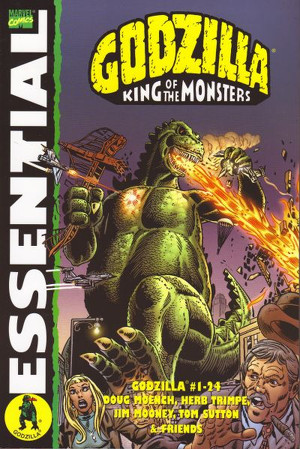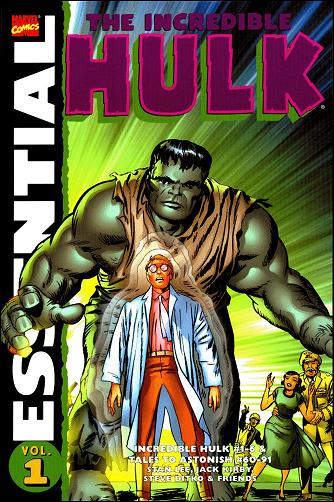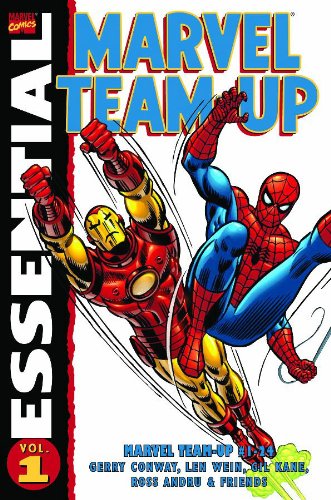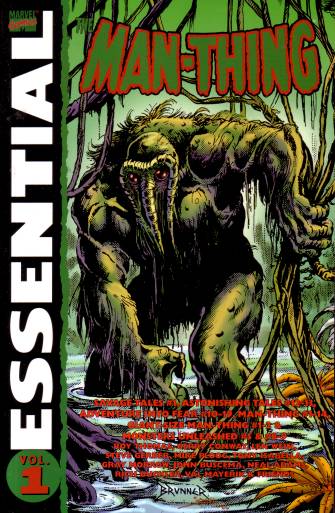
Essential Godzilla Vol. 1
Dough Moench, Herb Trimpe, Tom Sutton and friends
Reprints: Godzilla #1-24 (August 1977 – July 1979)
Get this for: Godzilla and nothing else — two stars
The Essential Godzilla is about as inessential as you can get, twentyfour issues of mediocre licencensed comics done by people clearly phoning it in. There’s nothing in here that makes it stand out from any other seventies Marvel title, apart of course from having a big green lizard as its hero. Nobody but the most diehard Godzilla collector needs this, but if like me you can get this cheap, you may still get some enjoyment out of its goofiness.
Because goofy it is, having a series starring Godzilla but set in the Marvel Universe rather than in its own continuity. Marvel used to do that quite a lot, starting with Conan where the connection was largely implied, whereas later toy based series like Rom, The Micronauts and
Shogun Warriors were an explicit part of the Marvel Universe. Their villains popped up elsewhere, they teamed up with other Marvel heroes and their plotlines would be wrapped up elsewhere. Godzilla wasn’t the most succesful of these titles but still managed to last two years, which is not too bad.
Godzilla‘s creative team was Doug Moench as writer, with Herb Trimbe as penciler and a succession of inkers including Fred Kida and Jack Abel as the art team, with Trimbe being replaced with Tom Sutton for two issues. Now Trimbe is not the sort of artist who actually has fans, lacking the creativity of a Kirby or Ditko, the style of a Steranko or Byrne or even the ability to create good art period. For most of his work at Marvel the best you can say that it’s servicable, helps tell the story and perhaps of most interest to his editors, dependable. He’s always been able to adapt to the reigning housestyle, (with ridiculous results in the Extreme! nineties) and his work here shows nicely what the Marvel style in the late seventies was. It’s a style that’s in the service of the plot, slightly dull and in Trimbe’s case at least very dependent on colour which in black and white makes his artwork less coherent. (In general, having read a half dozen essentials in close succesion now I can see that the better an artist, the better his work translates back from colour to b&w.)
The idea behind the series is that Godzilla has left Japan and is rampaging through America, with a special SHIELD team led by Dum-Dum Dugan on his heels attempting to capture him. Apart from Dugan other SHIELD regulars like Gabe Jones and Jimmy Woo are also present, while three new characters are introduced as well: Dr. Yuriko Takiguchi, Godzilla expert, his assistent Tamara Hashioka and his grandson Robert Takiguchi. The good doctor is there to wax wise on Godzilla, Tamara is a love interest for Jimmy Woo and little Rob is the only one who’s further developed. He’s unfortunately also a little whinger, completely obnoxious and after a few issues you wish Godzilla would step on him, what with his crying about the poor monster while whole cities are demolished by it. Godzilla himself is of course an innocent, peaceful until harassed, in the grand tradition of the Hulk.
The plots revolve either around SHIELD’s efforts to capture and imprison Godzilla somewhere or around some villain either framing Godzilla for his crimes or attempting to use him for them. Often other monsters are involved, as in issue #4 and #5 which introduced Doc Demonicus, who has bred his own little herd of mutated creatures like Batragon, half bat, half dragon. There’s also Red Ronin, a giant robot samurai armed with a laser shield and sword, hijacked by Rob to protect Godzilla from the Americans who ends up first fighting Godzilla, then teaming up with him against a trio of alien monsters wanting to enslave the Earth. These fights are the highlight of the series; the plots themselves are no great shakes and characterisation is sketchy.
Not really worth the twenty bucks Marvel wants for this, since you can read this in an hour or so, but if you can pick this up secondhand it’s a fun enough read.



